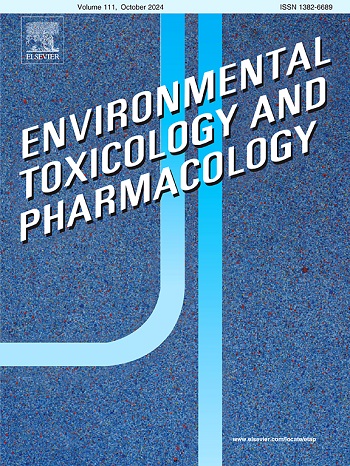Toxic effects of deltamethrin on oxidative stress, behavioural, organosomatic indices and histopathological changes in Digitonthophagus gazella (Coleoptera: Scarabaeinae)
IF 4.2
3区 环境科学与生态学
Q2 ENVIRONMENTAL SCIENCES
引用次数: 0
Abstract
Pyrethroids pose a great concern to the declining population of dung beetles and the sustainability of ecosystem services. This study aimed to investigate the toxic effects of deltamethrin on Digitonthophagus gazella. First, the LC50 value (0.275 ppm) was determined, and sub-lethal concentrations (LD; low dose-0.014ppm, MD; medium dose-0.028ppm, and HD; high dose-0.055ppm) were assessed for physiological effects. The findings showed a significant dose and time dependent increase in fluorescence intensity (DCF-DA staining) and a decrease in antioxidant activity, including superoxide dismutase (SOD), catalase (CAT), and glutathione (GSH). Furthermore, significant down regulation of cyp4g7, cyp6bq9, and cyp4q4 expression indicates enhanced oxidative stress. Additionally, a reduction in the organosomatic index, accompanied by histological changes in the brain, gut, and gonads, suggests potential functional disturbances. Overall, deltamethrin exposure had profound and irreversible pathological consequences on various vital organs and systems in D. gazella, affecting reproduction and nesting.
溴氰菊酯对 Digitonthophagus gazella(鞘翅目:猩红蛾科)氧化应激、行为、有机体指数和组织病理学变化的毒性效应。
本文章由计算机程序翻译,如有差异,请以英文原文为准。
求助全文
约1分钟内获得全文
求助全文
来源期刊
CiteScore
7.00
自引率
4.70%
发文量
185
审稿时长
34 days
期刊介绍:
Environmental Toxicology and Pharmacology publishes the results of studies concerning toxic and pharmacological effects of (human and veterinary) drugs and of environmental contaminants in animals and man.
Areas of special interest are: molecular mechanisms of toxicity, biotransformation and toxicokinetics (including toxicokinetic modelling), molecular, biochemical and physiological mechanisms explaining differences in sensitivity between species and individuals, the characterisation of pathophysiological models and mechanisms involved in the development of effects and the identification of biological markers that can be used to study exposure and effects in man and animals.
In addition to full length papers, short communications, full-length reviews and mini-reviews, Environmental Toxicology and Pharmacology will publish in depth assessments of special problem areas. The latter publications may exceed the length of a full length paper three to fourfold. A basic requirement is that the assessments are made under the auspices of international groups of leading experts in the fields concerned. The information examined may either consist of data that were already published, or of new data that were obtained within the framework of collaborative research programmes. Provision is also made for the acceptance of minireviews on (classes of) compounds, toxicities or mechanisms, debating recent advances in rapidly developing fields that fall within the scope of the journal.

 求助内容:
求助内容: 应助结果提醒方式:
应助结果提醒方式:


